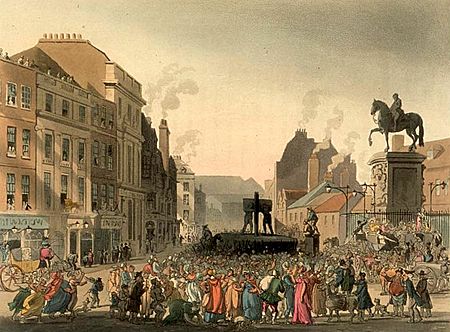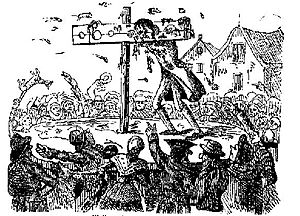Pillory facts for kids
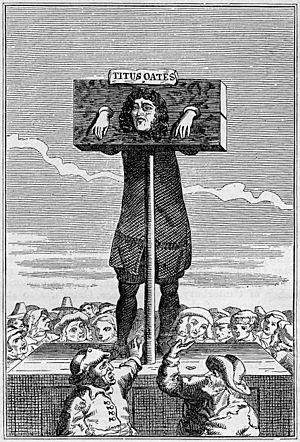
The pillory was a device used for punishment in the past. It was made of wood or metal and had holes to hold a person's head and hands. People were put in the pillory to be publicly shamed and sometimes to suffer physical abuse. It was similar to the stocks, another old punishment device.
Contents
What Was the Pillory?
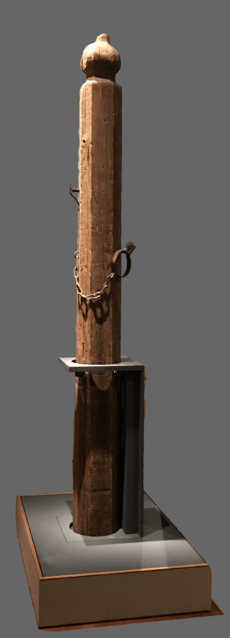
The pillory was like a set of hinged wooden boards. These boards had holes for a person's head and hands. Once the person's head and hands were in the holes, the boards were locked. This held the person securely in place.
Pillories were usually set up in public places. You might find them in marketplaces or at crossroads. They were often on platforms so everyone could see the person being punished. Sometimes, a sign was placed nearby explaining the crime. These punishments usually lasted only a few hours.
Why Was the Pillory Used?
The main goal of the pillory was to publicly shame someone. When people saw an empty pillory, they would gather to watch. They would then make fun of the person on display.
People watching often wanted to make the experience very unpleasant. They would shout insults and throw things. This included rotten food, mud, or even animal waste. Sometimes, crowds became very angry. They might throw stones or bricks, which could seriously hurt the person.
However, not all crowds were mean. For example, in 1703, Daniel Defoe was put in the pillory. He was a writer who had upset the government. But the crowd saw him as a hero. Instead of throwing rotten things, they threw flowers!
Other Punishments in the Pillory
While in the pillory, a person might face more punishments. Their hair might be shaved off. They could also be whipped, with the pillory acting as a whipping post. Sometimes, parts of their ears were cut off. This happened to John Bastwick, for example.
In some countries, like those in Scandinavia, the pillory was part of a church punishment. A person might first be shamed inside the church. Then, they would be taken to the "Shame Pole" for public humiliation.
When Was the Pillory Used?
The use of the pillory changed over time. In England, by 1816, it was mostly used for perjury. Perjury means lying under oath in court.
The pillory was officially stopped as a punishment in England and Wales in 1837. The last person to be put in a pillory in England was Peter James Bossy in 1830. He was punished for lying in court. He also faced prison time and was sent away to a distant land for seven years.
In France, the "pilori" punishment usually lasted two hours. It was replaced in 1789 and then completely stopped in 1832.
Different Types of Pillories
There were two main types of devices in France:
- The poteau was a simple post. It often had a board around only the neck. This was similar to the "shamepole" in Dutch.
- A permanent small tower was also used. The top part had a ring with holes for the head and arms. This ring could often turn around. This way, everyone in the crowd could see the person.
Pillories were often built to be seen easily. They were a symbol of the power of the law. Their constant presence was meant to stop people from committing crimes.
In Portugal, the device was called Pelourinho. These are important stone monuments. They are often found in town squares or near churches. They show the power of the king or queen. Many old Portuguese colonies, like parts of Brazil, also have these monuments. In Spain, it was called picota.
The pillory was also common in other Western countries. In the United States, it was mostly stopped by 1839. However, it was still used in Delaware until 1905. Delaware was also the last state to stop the punishment of whipping in 1972.
Similar Humiliation Devices
There were other devices like the pillory. One was called a barrel pillory. This was used to punish people who drank too much. It was a barrel that fit over the whole body, with the head sticking out. The person might have to kneel in the barrel or walk around town in it. This was meant to shame them.
While a pillory could be used to tie someone for whipping, they were different. The pillory was for public shame. Whipping was a painful physical punishment. Sometimes, a single structure had both a whipping post and a pillory. This was common among the Puritans in the Massachusetts Bay Colony. They used these to make sure everyone followed their religious rules.
Whipping posts were also meant to stop prisoners from misbehaving. Sometimes, criminals were tied down for a long time. They might be left without food or water, exposed to the weather.
Legacy of the Pillory
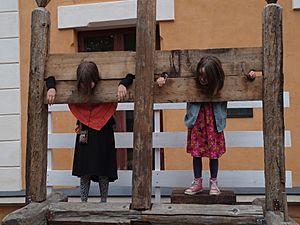
Even though the pillory is no longer used, the idea of it lives on. The phrase "to pillory someone" means "to expose someone to public ridicule or abuse." It means to shame someone in front of others.
Similar phrases exist in other languages. In French, it's "to nail to the pillory." In Dutch, the word for pillory means "pole of shame." This shows how important the idea of public shame was with this punishment.
See also
- Cangue, a board worn around the head
- Judicial corporal punishment
- Jougs, a metal collar
- Scold's bridle, a metal frame around the head to stop talking
- Shrew's fiddle, a board around the neck and wrists


